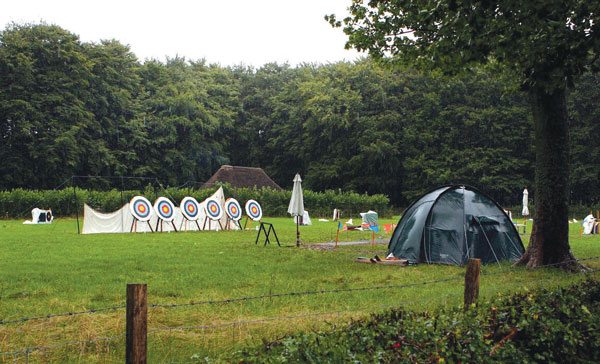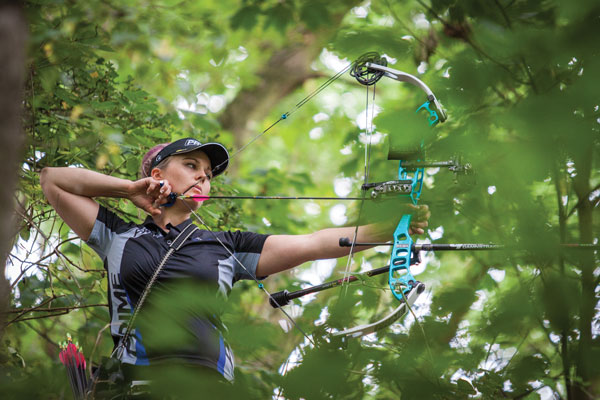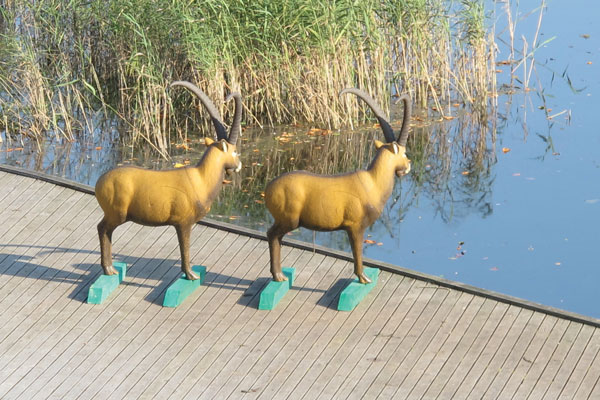
Alex Tyler presents a step-by-step guide, from location to security to finance
First, find your wood. When considering whether a site is large enough to put on a shoot, for each planned target, there will need to be the shot distance plus an overshoot zone behind (approximately 150m long by 50m wide on flat ground, to cover the potential distance travelled by an arrow). Ideally, the wood will have features of interest, such as hills and streams, to allow creative course-laying. Slopes can also provide natural back-stops, increasing the number of potential targets.
Typical arrangements for rent are an annual fee (which may be for unlimited access, or access only in specific periods eg avoiding the shooting seasons) or a fee-per-shoot basis. To check whether the rent asked is reasonable, consider the wood’s potential capacity and ability to put on shoots. A piece of ground may be large enough to lay out forty targets, which gives a maximum capacity for a shoot (at 6 archers per target) of two hundred and forty archers. However, this may not be achievable in practice. As an example, although archers can be asked to share cars, capacity should be based on a maximum of 1.5 archers per car, so if there is only have sufficient flat land to park forty cars, attendance can be a maximum of sixty archers (less club members’ own parking). The availability of volunteers and targets will also influence how many shoots can be run in a year.
Landowners, who may be used to the revenues from paintballing and shooting might try to charge significantly more than is realistic for an archery club (see club accounts box); this could be challenged based on the low level of impact on the woods from hosting a shoot. A formal agreement with the landowner should set out the obligations on both sides, including who else is allowed to use the woods and when.
You’ll need to think about vehicles, too; including an off-road area for parking. This, and the access routes to the site, have got to be accessible in the event of sustained bad weather. If hiring portable toilets or use external catering providers, routes must be also passable by vans (meaning higher clearance is needed). Visiting archers will need an area to congregate at muster and access to targets for warm-up. There will also need to be areas to provide shelter for admin and catering. You’ll also need to check at the beginning if the wood or nearby sites are designated (such as areas of outstanding natural beauty) as this may mean planning permission is needed to use or bring equipment into the wood.
Setting up the club
Field archery runs on clubs. From running regular open shoots to putting on courses for national championships, it is clubs providing the volunteer force which makes the sport viable.
Starting a club does involve organisation and work but rewards comes from seeing archers enjoy themselves and from making a contribution to the future of field archery. A area which should be fun is choosing a name and potentially a logo and colour scheme for the club.
Before a financial commitment is made, it is worth being clear on the club’s purpose and aims. This may seem obvious but stating these clearly at the beginning ensures that everyone who joins is working towards the same thing: as an example, each member to commit to a certain number of hours support to the club per year. The constitution should also define who is able to vote and who can make decisions on behalf of the club (the club’s officers). To amend a constitution typically takes a vote of a large proportion of the members (eg 75%) in favour, meaning that future decisions are made in line with the original aims. Examples of areas to be clear about are: which society the club will affiliate to and whether the club wishes to promote all types of shooting or a restricted range (e.g. just longbows).
A decision on affiliating to an archery society will affect both the style of shoots organised and the potential participants though it is possible to register a club with multiple societies. In the UK, there are two dedicated field archery associations: National Field Archery Society (NFAS) and English Field Archery Association (EFAA, which is affiliated to the IFAA). Archery GB also have a field section, though their prime focus is target. Working within a society allows coverage by their insurance, providing shoots adhere to their rules, which means mean completing risk assessments. This does not need to be an onerous task but it will include understanding what may go wrong and what actions need to be taken to prevent and recover from accidents. As an example, if the wood has a very steep section where the only emergency access is via a track which floods easily, that part of the wood would not be used if heavy rain is forecast. It is possible to find an insurance broker to provide bespoke archery insurance cover but this is likely to cost more and the insurer will still expect to see clear rules and procedures in place.
Existing clubs are scattered across the country but there tend to be concentrations in certain areas (eg the Midlands for NFAS and East Anglia for EFAA). A new club setting up a long distance from existing clubs may struggle to attract archers willing to travel to its shoots. However, if a new club starts within an hour’s travel of other clubs, it is courteous to co-ordinate shoot dates with established clubs to avoid splitting attendance (the national association may also help with this if they become aware of clashes).
You will also have to consider how the club’s finances will run. Subscriptions from members will be an important source of revenue for the club and these need to be based on what the club can offer and how much of a time contribution members are prepared to make. Other sources of income can be shoot catering (though pricing has to be carefully managed) and raffles. Limited national and local grants may be available but these are likely to be linked to specific commitments such as providing sports education or activities for young people.

Organisation
With the club basics set up, it is time to plan for the first shoot, which will mean acquiring equipment. The societies specify rounds and these will determine the equipment needed and influence courselaying.
A number of EFAA rounds use paper faces (either roundels or animal faces) normally set on layered foam bosses. For these shoots, there will need to be clear lanes from peg to target, which means pruning and removing all obstructions. For some rounds, distances must also be measured and clearly marked. The EFAA offer course accreditation, where the course can be assessed by an EFAA official, which makes it eligible for record status shoots. This does require the course to be laid permanently, which will be a consideration in the arrangements with the land owner. Some EFAA shoots use 3D animal targets; NFAS use exclusively animal targets, both 3D and paper faces and courses are set fresh each time. If facilities are available, making shooting pegs, signs and backstops can save money.
Acquiring a full course of 3Ds is a significant investment, but it might be possible to acquire second-hand targets (which can be refurbished) to get the club off the ground. All 3Ds require careful handling and a dry, secure storage space. Equipment is also needed to support the administration processes, such as shelter for the admin and catering teams and cooking equipment. Unfortunately, all these items are attractive to thieves or vandals: NFAS/ EFAA insurance does not cover losses, so additional cover may be needed.
The archery societies will publicise shoots through their magazines, but an effective way to raise awareness of a new club is through club members wearing branded clothing at other shoots. This can be part of revenue generation, too.
Safety and security should be considered from the beginning. Where land has a footpath crossing or adjacent to it, it is worth considering how much space this will affect. It is possible but complicated to get a footpath closed or diverted. Similarly, sites adjacent to populated areas may suffer from trespassers with risks of vandalism, theft or arson. Considering whether to store equipment and targets on site is not just down to how much space there is but also whether these will be sufficiently secure.
Good luck!



Very I formative thank you for the advise and guidance to achieve the start of an archery club.
Have to start a website too. Thank you.